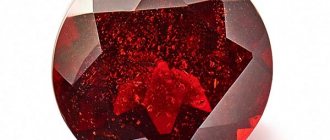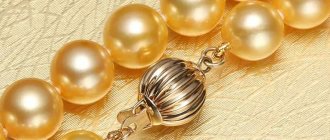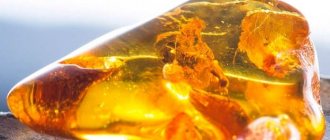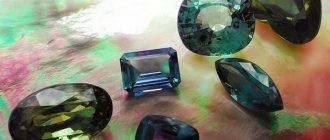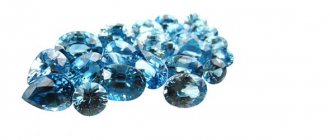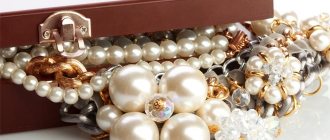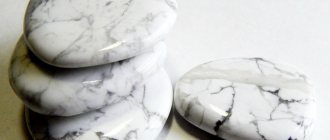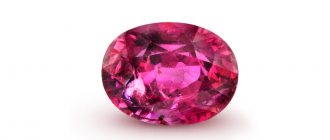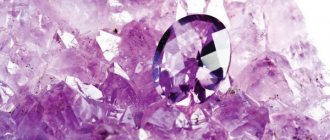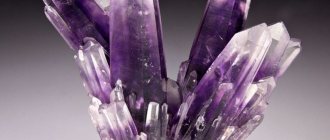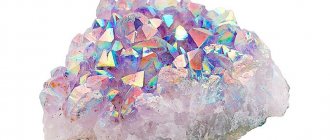Among the stones used in jewelry making, one of the most common is amethyst. Nuggets, the color of which varies from purple to pink, when skillfully cut, look incredibly organic on rings, necklaces, and brooches. Amethyst has been known since ancient times, when it was mined in Ceylon (now the state of Sri Lanka). Later, amethyst deposits were discovered in Russia and Prussia, and today this variety of quartz is mined in Siberia, the Urals, Germany, Brazil, Uruguay, the USA and Madagascar.
Amethyst: description and characteristics
Amethyst is a precious variety of natural quartz that comes in pink, lavender and purple hues. In rare cases, gems of green, blue and black are found. Such specimens are highly valued among jewelers and collectors.
In nature, the mineral is formed in the form of crystals with different levels of transparency. The color saturation of the stone depends on iron impurities. When heated strongly, it becomes colorless, most often permanently changing its color after cooling. The mineral also loses its color when exposed to direct sunlight - approximately 10% over 5 years of daily wear.
Amethyst is a fairly hard gem (7 out of 10 on the Mohs scale); in jewelry it is valued for its flexibility in processing. In lithotherapy, it is used to treat insomnia, calm the nervous system, and relieve alcohol addiction.
What are analogues made from?
Amethyst is a special, valuable variety of quartz. Most of the fakes passed off as quartz are grown artificially, using the same quartz as a basis. It is very difficult to recognize such patterns. The synthetic specimen is similar in physical characteristics to the real one.
Beautiful analogues are also made from materials such as:
- plastic;
- glass;
- artificial minerals;
- cheap natural stones.
Fluorite is often offered under the name amethyst; this crystal is similar to amethyst only in appearance. The hydrothermal method of growing stone analogues allows them to have some of the healing properties of the originals. There is nothing wrong with this method, but it is impossible to replace all the properties of a natural sample.
Origin story
Amethyst stone is translated from ancient Greek as “not drunk.” There is a beautiful legend associated with this name.
The god of winemaking and fun, Dionysus, fell in love with the beautiful nymph Ametis, who did not reciprocate her drunken suitor's feelings. Then the offended Dionysus decided to take the beauty by force. She could not escape from him and prayed to the goddess Artemis for help. She saved the nymph by turning her into stone. Dionysus immediately repented and poured wine on the stone, hoping to revive the beauty, but this did not happen. So the nymph became a beautiful purple mineral, endowed with the property of protecting people from drunkenness.
Synthetic or natural?
The jewelry market is dominated by artificially created amethysts. This is an intermediate stage between natural stone and synthetic stone; a fake is considered conditionally. The price of copies of comparable parameters does not differ much.
Amethyst
Their advantages: it is impossible to visually distinguish them from a natural crystal, they are unpretentious in use and care, they are indifferent to the sun, and constant wearing does not harm jewelry.
They do not work as a magical or healing artifact, but are suitable for all zodiac signs.
Zodiac sign Compatibility (“+++” – fits perfectly, “+” – can be worn, “-” – is strictly contraindicated) Aries+++Taurus-Gemini+Cancer+Leo-Virgo+Libra+Scorpio+Sagittarius+Capricorn+Aquarius+ ++Pisces+
You can choose jewelry with artificial and natural stones. To please yourself with some whenever you want, to leave others for special occasions, passing them on as a family treasure.
Varieties of amethyst
Jewelers divide amethysts into different types, depending on color:
- A classic purple stone, it is found in light lavender and dark purple shades. One of its rare varieties, “Deep Siberian,” combines purple with a dash of red.
- The natural green gem (praseolite) can only be found in Brazil. The price for such specimens is very high. They are characterized by needle-shaped inclusions.
- Black amethyst is the rarest and most mysterious type of mineral. Its deposits clear the surrounding area of radiation. It is believed that this gem has powerful energy, which is used by magicians and sorcerers in their rituals.
The variety of shades of stone depends on the oxidation processes of iron and manganese, and the interaction of iron with aluminum.
What does natural stone look like?
This violet-colored mineral is often counterfeited due to its popularity. It is worth knowing its true appearance and qualities.
The mineral has a purple color with different intensities of shades: from light lilac translucent to dark purple. The price of the product directly depends on the degree of color saturation.
Green minerals are found. Here you need to take into account that they are very rare, and under the guise of green amethyst, burnt quartz is most likely displayed on the store counter. The true green gem only comes from Brazil or the USA. It is not mined anywhere else.
You can recognize whether the stone in front of you is natural or artificial without resorting to complex procedures.
Types of fakes
Under the guise of a natural gem, various counterfeits are often offered:
- Colored plastic is the cheapest and lowest quality fake of amethyst, which can be visually distinguished even by a layman.
- Glass crystals, painted in the desired shade. In this case, it is more difficult to detect imitation. Glass is very fragile and susceptible to scratches
- Artificial amethysts grown on the basis of quartz. The synthetic specimen is practically no different in appearance from its natural original, but it lacks healing and magical properties.
- Inexpensive natural minerals that look like amethyst. Most often, cheaper fluorite, anthozonite, and inexpensive types of quartz, additionally colored and fired in a kiln, are passed off as a precious gem.
FLUORITE
Unlike other more expensive gemstones, amethyst is not always issued with documents confirming the authenticity of the stone. Therefore, to avoid substitution, you need to know how to distinguish an amethyst from a fake yourself.
What is used as a material for making counterfeits?
To make simple fakes, plastic and glass are used. Such samples are easy to distinguish from natural ones. Artificial crystals are less common in jewelry. High-quality counterfeits are not always detected even in laboratories. Sometimes other natural stones are passed off as amethyst.
Artificial crystals
The technology for growing synthetic amethysts began to be actively used only in the last 10 years. This was first done at the Lebedev Physical Institute in Moscow. Even large specimens are grown there, the diameter of which reaches 20-30 cm.
You can distinguish an inexpensive imitation thanks to the gap: the stone will lack inclusions characteristic of amethyst. It will be completely homogeneous. However, high-quality artificial crystals look like natural ones. In this case, the authenticity of the stone can only be determined in a laboratory way.
Glass
Glass counterfeits are most often used in cheap jewelry. It is not advisable to insert such a stone into a gold frame. Glass samples can be scratched even with a knife. They do not leave marks on porcelain. The fake has a uniform color and no inclusions.
Plastic
Plastic imitations are the crudest; even a person with no experience can distinguish them from the original. Such a fake easily heats up and scratches. It weighs little, and jewelry with it has a low price.
Cheap natural stones
Quartz and fluorite are sometimes passed off as amethyst. The first is irradiated with cobalt to give it a purple color. This imitation is characterized by instability of color.
The fake loses color when heated, even at home or in the sun. Fluorite has a similar hue, but is softer than amethyst. It can be scratched with a knife. Less commonly, synthetic chrysoberyls, cubic zirconias, spinels and sapphires are passed off as natural stones.
Under the sun's rays the stone will change color.
How to distinguish real from fake?
To verify the authenticity of an amethyst, you need to pay attention to the following characteristics:
- Brightness and color of the stone. This mineral is distinguished by a noble color palette, uneven coloring, and slight turbidity. A fake can be recognized by its brighter, “screaming” colors and impeccable transparency of the product.
- The structure of the gem. Air bubbles, microcracks, and needle-like inclusions are visible in a natural crystal. Glass and plastic fakes are distinguished by a perfectly smooth surface and an absolutely uniform structure.
- Density of the mineral. Natural stone is so hard that it will withstand the impact of any sharp object. If after checking there are small scratches left, it means it is a fake.
There are also ways to distinguish natural amethyst from synthetic:
- warm it in your palms - a natural stone will remain cold in your hands for a long time, an artificial one will quickly heat up;
- put it in a glass of water - a natural gem will have blurry outlines in the water, while an artificial gem will have a clearly defined outline;
- bring it into bright light - real amethyst will become uniformly colorless, unlike synthetic amethyst.
To be sure of the authenticity of the stone, it is better to buy amethyst from certified jewelry stores.
Professional inspection methods
Professional testing methods include spectral and x-ray diffraction analyses. They turn to laboratories when trying to distinguish natural stone from synthetic stone. Glass and plastic samples can be detected upon self-examination.
Spectral and X-ray diffraction analyzes
The spectrometer is a light source. With its help, you can determine the refractive index, study impurities, and even distinguish natural stone from artificial stone.
Thanks to the light, the specialist sees foreign inclusions, synthetic resins, organic compounds, etc. This method allows you to assess the authenticity of gems in a non-destructive way, including as part of jewelry, if the setting is not solid. Using a spectrometer, artificial coloring can be detected.
X-ray diffraction analysis determines the structure of the stone and the impurities that make up its composition. With its help, you can establish the authenticity of not only the gem, but also the metal of the frame.
This method also does not require destruction of the product or stone. To obtain a more reliable result, it is recommended to combine several methods.
Who does amethyst suit according to their zodiac sign?
The stone is ideal for Aries . It calms them down and helps them find harmony with themselves . In addition, the mineral restrains the ardor of Aries. They become wiser, cooler and more reasonable.
Another sign for whom amethyst is ideal is Aquarius. The violet crystal endows representatives of this zodiac sign with wisdom, gives them vitality and positive energy . In addition, it rids them of negative character traits.
The stone is also suitable for Pisces, Cancer and Sagittarius. In their case, it does not play a major role, but it does exist. With the help of a crystal, representatives of these zodiac signs will be able to find love and true happiness. They can also count on a strong and friendly family, financial well-being and good luck.
Amethyst is strictly contraindicated for Taurus and Leo!
The rest of the zodiac signs can take a closer look at him. They will have a neutral relationship with the mineral.
Compatibility of amethyst with other stones
The gem is under the auspices of Saturn and Neptune.
The mineral is associated with the element of Air. Therefore, it is not compatible with every crystal.
Astrologers advise choosing options with neutral or friendly energy.
Amethyst goes best with stones such as:
- Diamond . Crystals enhance each other’s effects, allowing a person to unlock their potential and achieve their goals.
- Smoky quartz . It is associated with the element of Air, so the gems are ideally combined with each other.
- Tourmaline . When combined with amethyst, it creates a protective field against negativity. In addition, together they give strength, give a good mood and positive energy.
- Citrine . The gem is also associated with the element of Air. The combination of amethyst and citrine has a positive effect on a person.
